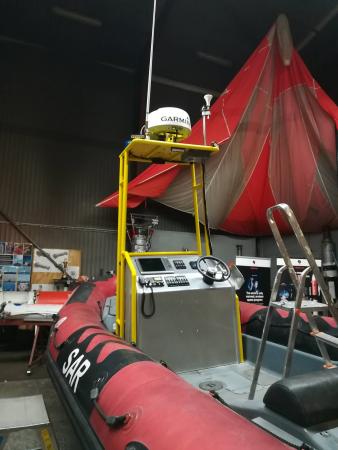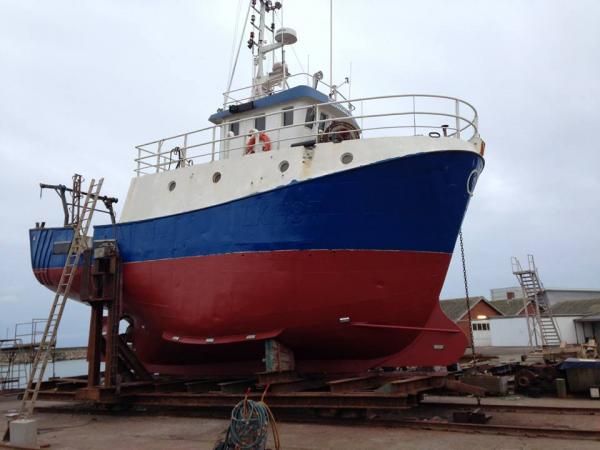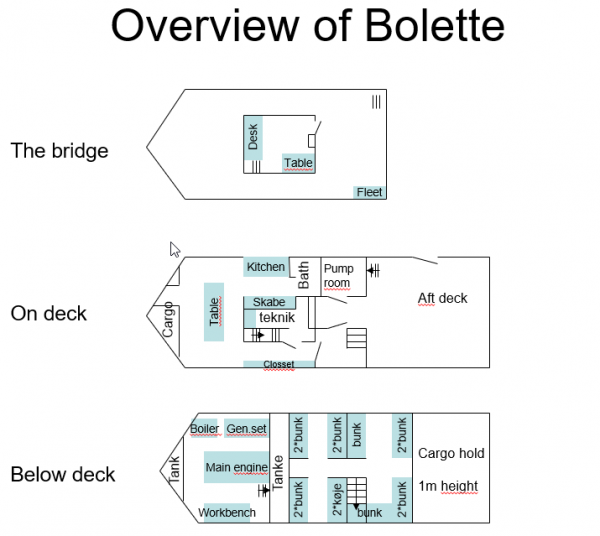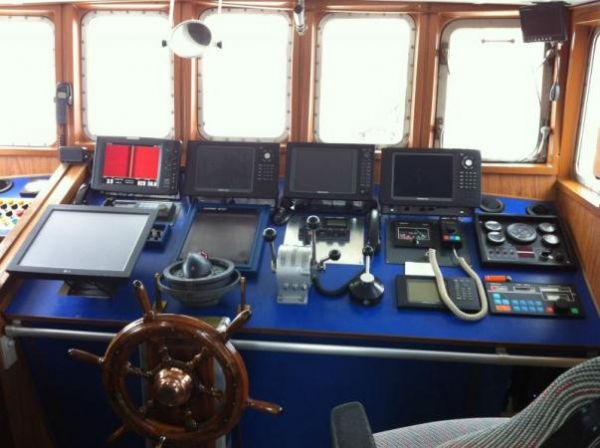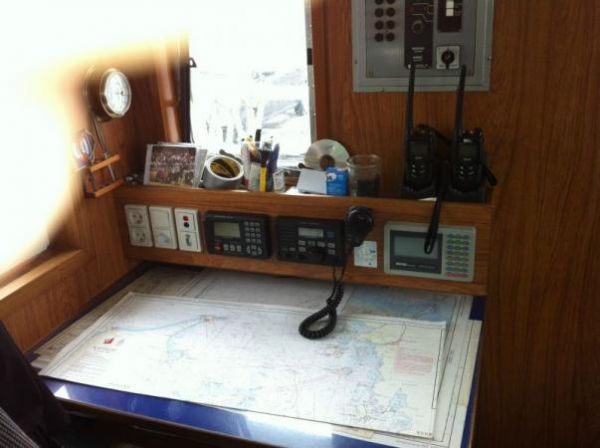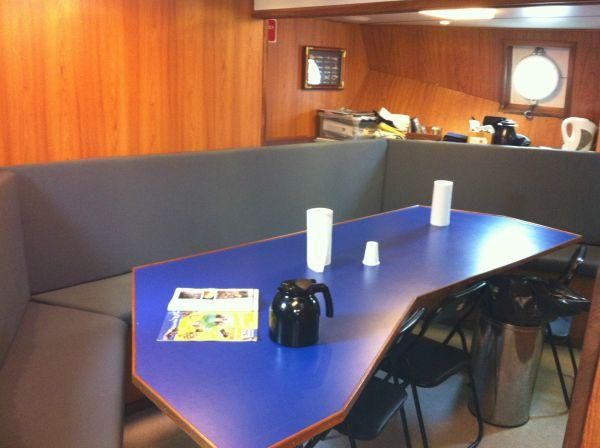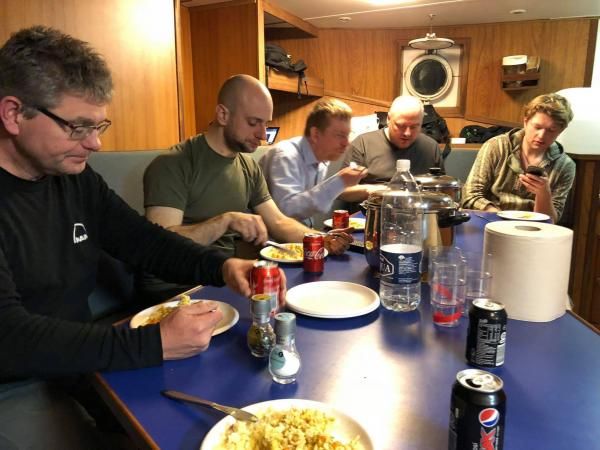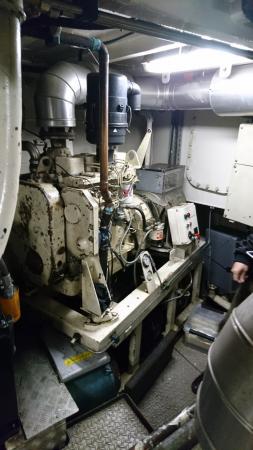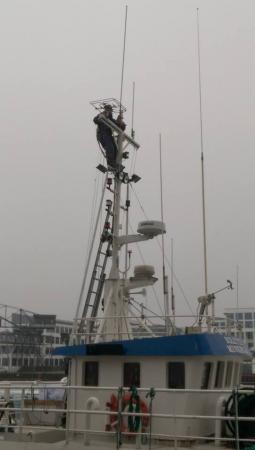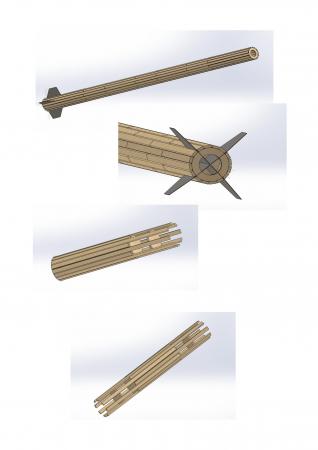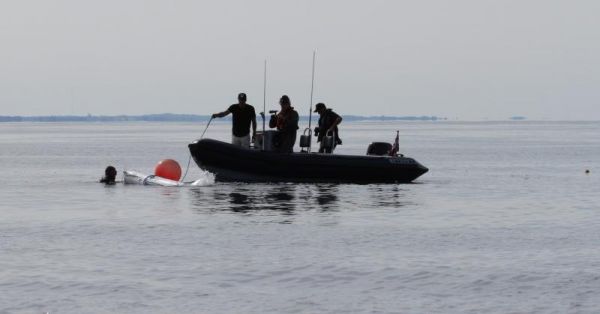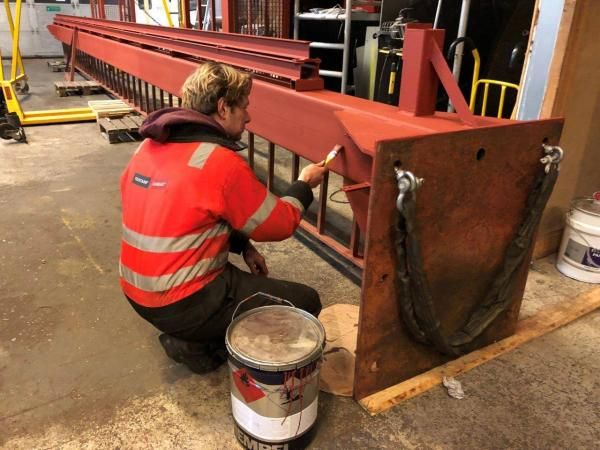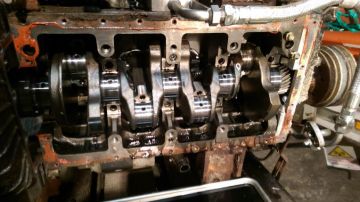Upgrade – Bolette, almost build for CS
It’s happening – We can’t believe it…. The sun is shining and it’s above 5 degrees. Even though it has been cold, we have worked over the winter. However, it has not been so comfortable when there almost were frost on the tables in the workshop. You have been able to follow our work in blogs and on Facebook. Minor updates are quickly on facebook. It takes a little longer to write a blog. Besides the projects taking shape in our workshop, we’ve also started project “Mission Control Ship”. Here is a video with a guided tour of our new Mission Control Ship.
Now why this – Was Vostok not ready?
Yes, it is correct that Vostok was somewhat ready to support our launches on the Baltic Sea. So why a new ship? Here’s a brief review of why we chose to retire Vostok.
Vostok was the ship we could afford 4 years ago – This does not mean she was a bad choice. At the same time, we were in a situation where borrowing a ship for launches was no longer an option. Vostok was a rescue ship and had served the Deutsche Gesellschaft zur Rettung Schiffbrüchiger (DGzRS) for 25 years (https://www.seenotretter.de/wer-wir-sind/flotte/). Then she sailed in Iceland as a rescue ship before she was sold to England as a diving ship (we have something with diving ships apparently). The last station before we bought her was in Norway as small guard ship.
In Germany and the United Kingdom, it is private volunteer organizations that primarily rescues leisure boats. In Denmark, Dansk Søredsselskab is getting the same role (http://www.dsrs.dk/), though on a much smaller scale than their German counterpart.
As a side remark, we have had a good deal of cooperation with DSRS, partly because of our member André, who is rescue trained in the fleet, is in the local department of DSRS who has the RIB « Lynette Rescue » in Magretheholm Port. Unfortunately, a couple of times we have needed their « service » to get Vostok back to port due to technical problems, so we are good friends. Finally, they have borrowed a little space over the winter for a refurbishment of their RIB, so it’s ready for this season.
- Illustration: DSRS
- Illustration: DSRS
During the winter and spring in 2016/17 we performed major maintenance work on Vostok. She got her main tanks cleaned, went on the slipway in Nexø and was generally reviewed. Here we found quite a few issues. Some were corrected immediately (including hull repairs) while others were put on a waiting list. However, this waiting list became quite long, and we lacked enough people with the right competencies. In other words, it became increasingly difficult to find the time to maintain a rescue ship from 1969 and build rockets. The reason why maintenance was particularly difficult was that Vostok was meant to have a permanent crew, regular engineer and maintained as a working tool in an organization where money was spent on a fixed periodic maintenance. She was built more like a navy vessel, with great redundancy in many systems. We had to acknowledge that it did not match well with our type of organization. There started to be too many items that were too hard to maintain for us.
Therefore, it was with great interest that we saw that Nørresundby Sports Diving Club (https://nskdyk.dk) would like to sell their ship Bolette Munkholm.
Facts
- Name: Bolette Munkholm
- Build: 1980 – Norway
- Tonnage: 61,9 brt.
- Dimensions: 14 x 5 x 2,80 m
- Accommodation: 14 persons
- Wheelhouse: Aluminum
- Cargo hold: 14 bunks, divided into cabins like so: 2 x 4, 1 x 3, 1 x 3 persons.
- Enging: CUMMINS NTA 855 6 cyl. 400 hp, installed in 2001, Volda Gear.
- Auxiliary engine: CUMMINS 13 kWH, 380 v.
- MOB: 6 pers. rib, 25 HK.
- Fuel capacity: 6500 l
- Freshwater capacity: 2000 l
The ship is a converted fishing boat. The purpose of the rebuild was to get a functional diving boat. On their website, the complete story is told, it was a very big and impressive project. However, there have been changes in what members of the diving club wanted. Several now prefer day trips in a RIB boat. Therefore, it was too much to have a larger ship that is not used enough. When we approached, there was great interest in that we purchased the ship. We are a volunteer association like the diving club itself. We wanted to maintain the ship in its current design. The alternative would most likely be a conversion back to fishing vessel again, and the club was not really interested in that. That’s why we have also got a very good agreement while we get the final financing in place. This is also the reason why the name is retained so far. At the same time, we explore opportunities for occasional sailing with the diving club members. Time must show how we can make the most of it for both parties. We have been given access to a well-maintained ship that suits us very well.
The interior – is it better?
A big resounding YES 🙂 Certainly, Bolette is born as a business boat, but not one to be available with a minute’s notice to save others. The ship is built as a fishing vessel, with practical solutions that can be maintained by a few people. She was then converted to diving vessel. The whole ship has been given new entrances, and although diving and rocket launches do not immediately seem to have much in common, there are many overlaps.
The ship has some newer technology, including chart plotters, echo sounder, radios and more. Bolette is a very well-equipped recreational craft that can support a diving trip with up to 14 participants. In fact, this means that we can have all the people we need for complete a rocket launch and subsequent recovery on board.
That is, we have a lot more table space and deck space, and although we lose the ramp intending to recover rockets, we have instead a crane available. This is something we have long wanted since a crane is more flexible than the ramp. Before we got Vostok we also used a crane.
Technically, the engine room is far more user-friendly. There are of course compromises. We lose speed compared to Vostok and her powerful 900 hp machine. On the other hand, we get a Cummins main engine and light engine that has been manufactured in thousands and which can be obtained relatively easily (and cheaply). Everything is made to be serviced by a two-man crew. Alone the full headroom in 80% of the ship is a luxury.
What’s needed? Are you ready soon?
Yes, things are moving forward fast. Of course, some equipment must be installed that you do not need on a diving boat. Therefore, we immediately assembled a work group when the ship arrived at Copenhagen. A plan has been made for how we get Bolette ready for launch. We have prioritized the tasks so that we can concentrate on the most important first.
There are three functions covered by the ship during a launch. If we speak in space terms, Bolette is both launch, mission and recovery control. This is a combination of features we can do as we still fly relatively simple rocket systems. How it will be in the future will be investigated further later. Right now, one ship can manage all the tasks. In addition, the ship is also a communication link between all parts of the launch. That is, both the communication between the ships, small boats, any aircraft and of course the rocket. All streamed video communication also goes through the ship. Therefore, there are some subsystems that need to be setup and tested throughout the coming period.
Here are the main parts of the preparation we’re performing:
Network, cabled – We need network cables to all rooms on the ship. All communication between all parts of mission control is wired networks. Only the Sputnik link is wireless. At the same time, it is also here that video streams are transferred to the servers and processed before the WLAN data link sends it to the land station.
WLAN datalink- Home-built system for communication from Sputnik to Bolette, and from Bolette to Dueodde (Bornholmer tower).
Server room (in the cargo hold) – Here’re the servers set up by streamteam master Peter Mærsk they are controlled from Copenhagen. The two servers collect and mix video, so we can get live video to you. Cooling will also be established. From experience we know it can get hot at sea.
UPS / emergency power – UPS is installed to cover all devices in the network. At the same time, there is also UPS on the ship’s communication and navigation equipment. Much of this already exists and just needs to be integrated into the overall solution.
Antennas – We never have enough! Additional VHF / UHF antennas, WLAN rotors for transmission to land, satellite phone etc. must be set up. Everything that needs to be used to keep in touch with authorities, other ships and to the internal radio channels we use.
The GPS compass from Vostok is installed on Bolette. This was the only system Bolette did not have, as it is primarily on larger commercial vessels. We need the great precision to control the data link to Dueodde. Otherwise, the two WLAN antennas cannot track each other.
Antenna tower for telemetry, telecommand and video from the rocket is made in a more permanent installation than on Vostok. In the long run, there is the possibility of auto tracking instead of the manual way we are using today.
Of the more non-technical installations, everything is being reviewed. Nordjyllands Dykkerklub has not used the ship particularly much in the last year, so there’s some maintenance on crane, diving compressors and so on. There’re no major issues, but it must be done. It’s no different than servicing a car in many aspects,
A sun rack must also be made for the open section of Mission Control itself. The combination of sun, rain and IT equipment is not optimal, so as on Vostok we need a cover so that we do not get burned or rain away. In addition, we do some securing of the boat, since it’s not on a locked dock as in Aalborg.
Are you happy now?
In general, I can say yes, very much 🙂 We have a ship which is significantly better fitted that Vostok. It generally provides better working conditions for everyone in the team, and facilitates communication during both the preparations, the launch and recovery operation. At the same time, Bolette is easier to get running. Because the engine is smaller, heating before startup is shorter and the entire startup process is more like a lorry. Vostok had its rough sides and startup including heating which took a good half hour (900 hp engines are just a big block metal). This means it’s easier to perform training trips in the evenings.
We have also decided to make a more formalized work group around the boat. The idea is, among other things, that it will be easier to recruit members who have the boat as their primary focus. This has in fact been the case for several members already. It does not mean that you cannot work on rockets, but we must acknowledge that not all members have many hours to spend each week. We are a project based on people’s spare time, and if we split things up we can ensure that more people can help, yes, it’s a pure win-win, as you say in advertising business. The more good seamen we have, the easier it is to get the launches to go as planned.
Recovery – How will that work?
Here we (or rather Jesper) have taken the opportunity to get the recovery of the rocket trained well. Because it’s a new boat, some tests must be done and the recovery itself will be trained. Jesper has written the following about recovery and training.
Now that we have a new ship, we also must create a new recovery procedure, for how we get Nexø II out of the water after it has fallen slowly from the sky below its parachute. We have a crane on the aft deck of Bolette that we expect to use for the recovery. To prepare and train a recovery procedure, we in the marine department would like to borrow the rocket and throw it in the water and pull it back on board again a whole lot of times. Strangely enough not so many thinks this is a good solution.
We are therefore building a recovery dummy for training purposes. It is a 5.8-meter-long model of the rocket built of cheap boards and plywood. The wooden rocket will weigh about 100 kg, approx. 2/3 of the landing weight of the real rocket. At the ends it will be possible to put weight blocks to change the center of gravity and hence the way it lies in the water. It’s not critical that it doesn’t weigh the same as the real rocket, the important thing is that we get to exercise how to handle a long rocket in the water.
The procedure for securing the rocket on the sea surface is the same. The plan is still that RIB secures the rocket and then Bolette sails to the rocket or it is dragged over to Bolette by the RIB boat. The actual salvage will look much like it did when we used MHV 903 Hjortø earlier.
Marinedepartment – What’s missing?
Besides Bolette, Sputnik must also be ready. Her mast and launch rail has been cleaned and painted in HAB during the winter. It was dismantled with the help of a crane in the fall.
It is now ready to get mounted on Sputnik again. Then we need to check all cables etc. used during launch. We’d like to have wired the different video stream positions better. We achieved a good deal this fall, but of course, everything must be checked again.
Ad Astra.
